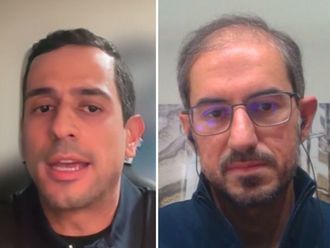Dyslexic patients have trouble reading and even pronouncing words properly. How does one diagnose a dyslexic? Friday offers some useful tips
It was sheer desperation that led Ahmed to meet his family doctor. Ahmed was a successful 30-year old dentist who wanted to change his profession and pursue a degree in business. However, he was petrified that he would not be able to cope with large amounts of reading and suspected he could be dyslexic.
He asked his doctor if there was any way of finding this out, and how would this diagnosis impact his professional life? Puzzled, the doctor asked Ahmed how he had managed to go through his medical college. Ahmed laughed and said, "I worked three times as hard as everybody else!"
In the course of an interview with him, Ahmed revealed that an uncle and a cousin sister had both been diagnosed as being dyslexic. Ahmed is just one among thousands of young adults on the verge of discovering that he could be dyslexic.
"The relief that I can at last name my problem is indescribable," he said. "All through school and college, I could never stand up in front of the class and read. Even talking was hard because I would often misuse words."
Ahmed's courage in coping with his reading difficulties is a tribute to the immense effort that must have gone into his medical studies, a courage that no formal assessment can ever measure!
Easy to diagnose
Diagnosing dyslexia in adults is not difficult because there is so much of clinical information now available about how dyslexia begins and evolves over time. Recent research clearly states that one persistent trait that marks the adult dyslexic is the 'phonological' deficit.
Phonemes are the building blocks of all spoken and written language. The word cat for example, consists of three phonemes: k, aaa, t. In children and adults with dyslexia their ability to recognise and manipulate phonemes (of any language) are less developed.
This weakness does not allow automatic 'decoding' of letters and words. Fortunately, as Dr. Sally Shaywitz points out, "it is our cognitive capability and not our phonology that allows us humans to reason, analyse and solve problems, and be capable of great accomplishment".
So though Ahmed is still not a fluent reader, he is quite capable of understanding what is read to him. And, surprisingly, he can read words in his medical books because he has spent years over-learning them.
Dr. Shaywitz suggests that the best way to diagnose an adult dyslexic is to look at his learning history, and more specifically, at aspects such as the time taken to read, write, spell, and complete tests and examinations. Even the most brilliant, hard-working adult may not be able to read fluently.
A casual review of Ahmed's school report cards would probably carry comments from his teachers such as: "Ahmed reads slowly and fails to recognise common words"; or, "Ahmed needs extra time to complete his assignments".
In children, the phonological weakness affects reading accuracy; in adults it affects the speed of reading because the phonological weakness persists and never goes away. Brain imaging studies show that adult dyslexics never switch over to the automatic reading circuit necessary for fluent reading: they read accurately but slowly.
When asked to read aloud, the adult dyslexic would probably mispronounce words, omit or insert words, hesitate, and take a long time to read a passage.
Never too late
How do adults overcome their reading problems? It is never too late to learn to read, and adults are probably far more motivated to read than second graders because they know the stakes are high.
For example, one has to be able to read a variety of printed materials – bus and train schedules, menus, forms, instructional manuals etc. – in order to function in daily life.
The first step is to enrol yourself in an adult literacy programme. A reading test should be administered to identify the precise gaps in the person's reading development, and determine the starting point for instruction. Adults do well in small groups as they learn well from each other.
Ideally, two-hour sessions at least twice a week is good. Encourage attendance and regularity because many young adults have responsibilities at home and at work, and tend to drop out of a program quickly. It is important they practise at home too.
A good reading programme should find the adult has reached Grade XII reading level in about three years.
Coping with dyslexia
It was sheer desperation that led Ahmed to meet his family doctor. Ahmed was a successful 30-year old dentist who wanted to change his profession and pursue a degree in business.












